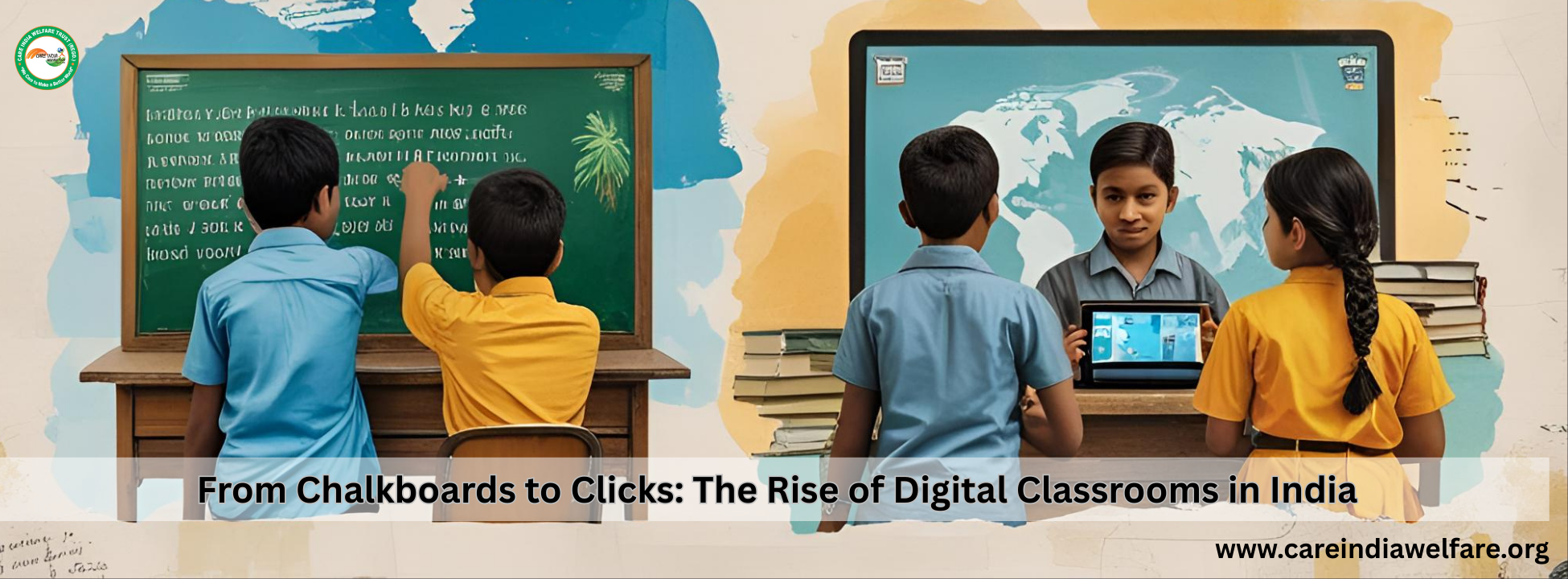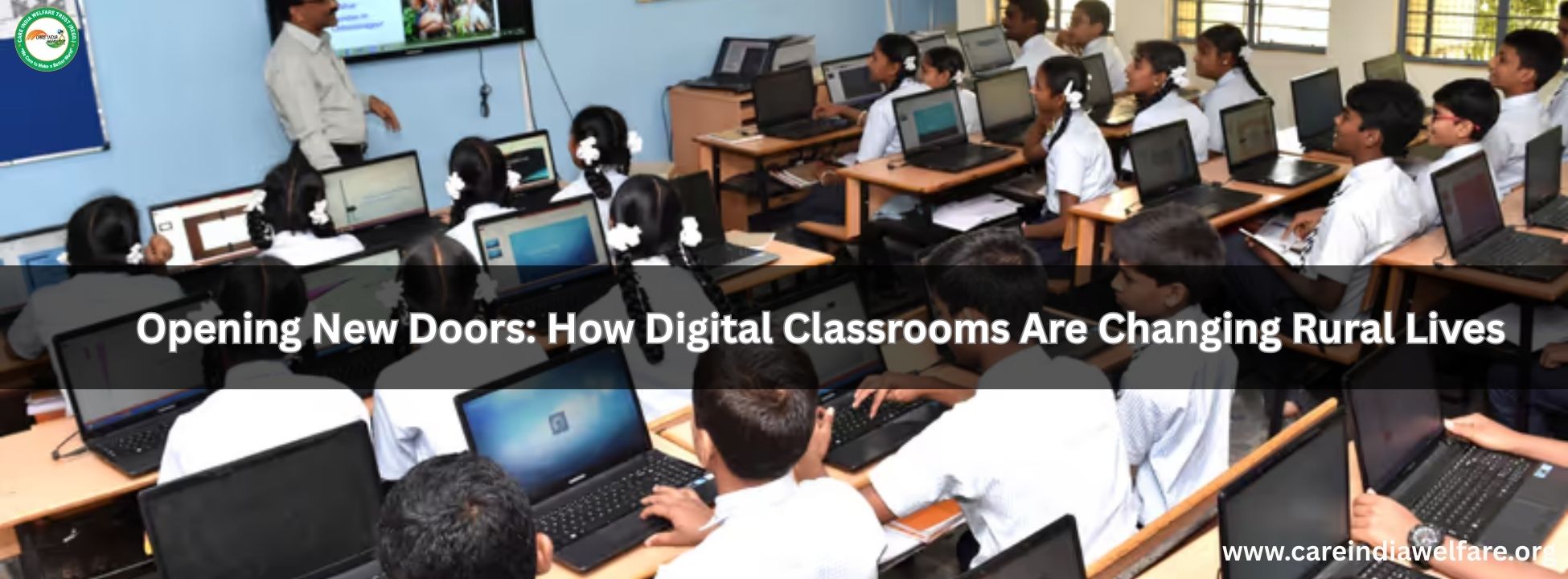There is a wide gap between childhood learning in an urban area and childhood learning in a rural set-up. Whereas Indian classrooms in cities have state-of-the-art setups, trained teachers, and internet facilities, rural areas still mostly hold onto blackboard teaching, and in some cases, the children do not even have proper books. This disparity is called the Rural–Urban education divide.
Digital classes in schools are helping to bridge the two ends of the gap. Through tablets, smartboards, learning apps, and video clips, village children can now enjoy their lessons in a more entertaining, lucid, and productive way. All of these elements of smart classroom education have made it possible for rural children to study the same lessons as their city counterparts.
With the rise of smart classes, more and more schools are turning to technology for better outcomes. In many parts of the country, Smart Classroom India initiatives are making it easier to introduce digital tools even in remote areas. These steps are transforming how students experience learning across the nation.
Why Do Rural Students Still Crawl? Off-loading the Education Divide
As someone who works closely with rural communities, I’ve witnessed firsthand the many challenges rural students face. While urban students benefit from well-equipped schools, highly qualified teachers, and access to digital tools, their rural peers often struggle with the most basic needs. Many rural schools operate in dilapidated buildings, with no electricity, no proper toilets, and limited access to textbooks or even blackboards. Kids walk several kilometers just to get to a school, only to discover an untrained teacher and no actual learning materials to greet them.
But the issue goes beyond that. The digital divide is the new face of inequality. In urban areas, online learning is the norm—kids have their own devices, broadband connections, and exposure to learning technology from a young age. Meanwhile, countless rural families don't even have smartphones, let alone computers or internet connectivity. The resulting learning gap is enormous and continues to grow year by year.
But the rural lag is not necessarily about the lack of technology. It is the result of decades of neglect, policy void, and inadequate investment in rural education. To close the gap, we have to see beyond patches. We require inclusive policies, long-term investment, community participation, and mass awareness campaigns that focus on the fundamental problems.
The potential is out there. With the appropriate help and the thoughtful inclusion of online classrooms, rural students can finally receive the education they are entitled to—equal, empowering, and full of possibility.
From Chalkboards to Clicks: The Rise of Digital Classrooms in India
The learning of children in India is no longer the same. Rural education in India has evolved significantly. Classrooms previously only had chalkboards, textbooks, and a few simple tools. But today, we're witnessing a huge move towards digital education. I still recall my first-ever glimpse of a smartboard in a school in the rural areas—it was thrilling and full of expectations. Whereas before they would listen to the teacher only, now students could view videos, take online quizzes, and learn from images and animations. It made learning enjoyable and simpler to comprehend. This highlights both the importance of education in rural areas and how the problems of education in rural areas are slowly being addressed.
During the COVID-19 pandemic, this shift occurred even more rapidly. With schools shut down, educators and students needed to go online. Most began using Zoom, YouTube, and smartphone learning apps to maintain their studies. For the first time, students were able to pause and replay classes, learn at their own pace, and delve into things they wanted to know. This level of flexibility is something that cannot be found in traditional Indian classrooms.
But technology in itself won't do. It's necessary that teachers be taught to use them and that parents and communities back this shift. That’s why schools and NGOs are now turning their attention to training teachers in online methods and fostering trust in new learning systems—key steps in solving the education in rural areas problems and solutions. In places like Nabha, introducing a digital learning platform for rural school students in Nabha has become an important way to ensure children do not miss out on quality education.
Digital classes in schools and the rise of smart classes speech are proof that smart tools work. Virtual classrooms are opening new gates for the students, particularly in rural regions where quality education has always been a challenge always. It is not a trend; it is a forceful movement that is transforming the future of education in rural areas in India through the elements of smart classroom models now being adopted.
Smart Tools, Smarter Learning: The Technology Powering Digital Education
At the heart of every effective digital classroom is robust technology. These intelligent tools are revolutionizing the way children learn, and the way teachers teach. With tablets and projectors, learning apps, and online platforms, technology is transforming education into an exciting, fun, and efficient experience.
I’ve personally seen how happy students get when they use educational games or try virtual science experiments. It doesn’t feel like boring study anymore—it feels like fun! Many of these tools are also available in local languages, so students from rural areas can understand and enjoy them easily. Some apps even use videos, animations, and quizzes to explain difficult topics simply.
Technology benefits teachers as well. With online training, teaching materials, and progress trackers for students, teachers can perform their work more effectively and with less effort. They are able to identify which students require special attention and provide individual attention. Even pre-recorded lessons enable students to view again if they do not comprehend the first time.
One of the most thrilling aspects is how NGOs like us are taking this technology to villages. We provide tablets, fit projectors, and initiate learning apps that can function without an internet connection. It's not merely a matter of providing gadgets—it's a matter of providing opportunities.
The goal is not to displace teachers but to empower and assist them. Used in the right manner, smart tools have the ability to make every classroom a room of possibilities. Bit by bit, we are creating smarter learning for all children, regardless of where they live.
Opening New Doors: How Digital Classrooms Are Changing Rural Lives
Technology benefits teachers as well. With online training, teaching materials, and progress trackers for students, teachers can perform their work more effectively and with less effort. They are able to identify which students require special attention and provide individual attention. Even pre-recorded lessons enable students to view again if they do not comprehend the first time.
One of the most thrilling aspects is how NGOs like us are taking this technology to villages. We provide tablets, fit projectors, and initiate learning apps that can function without an internet connection. It's not merely a matter of providing gadgets—it's a matter of providing opportunities.
The aim is not to replace teachers but to support and empower them. Employed properly, intelligent tools can turn any classroom into a room of possibilities. Gradually, we are building smarter learning for all kids, no matter where they are from.
Parents who previously believed education was a luxury are now appreciating its value. They are attending digital awareness workshops, encouraging their children, and even assisting in the installation of technology in nearby schools. Volunteers from the same communities are volunteering to assist with digital tools and training.
Girls, who previously had to drop out of school early, can now continue their education from home with the aid of mobile phones or communal tablets. This translates to more girls remaining in school and making a future.
E-learning is also enhancing job readiness and life skills. Gradually, digital learning is taking families out of poverty and providing them with the hope of a better tomorrow. When a child in the rural area attends a virtual class, he or she is not merely learning but is dreaming more and looking further.
Signal Lost? The Real Challenges of Bringing Tech to Remote Schools
Digital classrooms are wonderful in theory, but reality in most rural schools is rough. I've been to a village school where they had a smartboard installed, but they couldn't use it since there was no electricity for days. In the absence of electricity, the greatest technology is of no use.
Another significant issue is internet access. Most villages have poor or no internet connectivity, which renders online learning challenging or impossible. Even if students receive devices such as laptops or tablets, at times they get misplaced, stolen, or damaged. This makes it difficult to sustain digital learning.
The teachers are also under challenge. They are not equipped with the knowledge to handle new technology or apps. Unless they are given proper training, they feel lost and are unable to assist the children. Some kids also do not own smartphones or tablets, and some even lack basic necessities such as food, impacting their concentration on studying.
To solve such issues, we require more than just technology. We require proper infrastructure, such as electricity and internet in schools. We also need solar power alternatives for areas with no normal electricity. Offline educational material should also be available to enable children to learn in the absence of the internet. All content must be in local languages to facilitate better understanding by the students.
Capacity building of local people is also necessary so that assistance is readily available even when NGO teams depart. All these issues can be addressed through collaboration among governments, NGOs, and nationals. We need to continue to ask: How can we ensure no child is left behind in school?
Who’s Making It Happen? Government and NGO Heroes in Digital Education
This digital revolution wouldn’t be possible without the efforts of countless unsung heroes. Government schemes like DIKSHA and PM eVIDYA are making educational content accessible across states. NGOs are also playing a crucial role. In our organization, we’ve distributed thousands of tablets, set up digital labs, and trained teachers in remote schools. Partners like local tech firms and CSR-funded programs provide essential hardware and internet solutions.
Cooperation is paramount—schools, communities, governments, and nonprofits have to collaborate in creating a sustainable digital ecosystem. Volunteers from urban areas mentor rural kids virtually. State governments are adopting blended learning modules and investing in e-learning hubs. We’ve even seen retired teachers contribute by recording video lessons. These collective efforts show that when different stakeholders come together with a shared vision, real change happens. Digital education is not a dream—it’s a growing reality, thanks to the people behind the scenes.
From Remote Villages to Real Results: Inspiring Success Stories
Each time we hear a success story from a child in a rural area, our mission gets energized. Such as Rani, who used to miss school to assist her mother in the fields. With a tablet and adaptive learning hours, she became a topper in her class and now guides others in her village. Or Arjun, a young boy from a far-off village who learned English via an app and cleared a scholarship test. These are not isolated instances. Nationwide, online schooling is making a real difference. Students are outcompeting others in competitions, getting into better schools, and even assisting their parents with digital activities. In higher education too, the idea of a remote classroom for rural colleges is opening doors for students who earlier had no access to quality professors or advanced courses.
What is lovely is the way these children become role models for others around them. They develop curiosity among their siblings, peers, and neighbors. When one succeeds, there is a ripple effect. Sharing these tales not only inspires but also encourages building confidence in digital solutions. These outcomes demonstrate that even at the farthest edges, there can be excellence—if the right tools are provided. That is why many institutions are now introducing digital classrooms in school, helping students learn in modern and interactive ways.
Teachers 2.0: Guiding the Next Generation Through Screens
Teachers remain the heart of education, even in digital settings. But their role has evolved. I’ve seen teachers who once hesitated to use smartphones now lead virtual classes with confidence. They’ve become facilitators, guiding students through videos, apps, and online assessments. Training is essential—many NGOs and government bodies now offer digital literacy programs for educators. These efforts are paying off. Teachers are learning how to blend traditional methods with tech-driven strategies.
They're applying storytelling videos to describe intricate ideas or facilitating peer learning with online discussions. It's also about feeling connected—teachers are applying WhatsApp to maintain contact with students, guide them during difficult times, and encourage them when studying becomes difficult. This human-technology mix is compelling. When teachers adopt digital tools, they do not lose value—they raise it. As one teacher told me, “I’m not just teaching a subject anymore. I’m preparing students for a digital future.”
No Internet, No Problem: Innovative Ways to Build Rural Infrastructure
Building a strong rural education infrastructure without reliable internet is a big challenge, but there are many smart solutions. Here are some innovative ways to overcome this problem:
- Offline Digital Content: Using pre-loaded tablets or USB drives with educational videos, books, and quizzes allows students to learn even without internet access.
- Community Learning Centers: Setting up local centers with solar-powered computers and digital resources where students can gather and study together helps share limited resources.
- Solar Power Solutions: Many remote areas lack electricity, so solar panels provide a clean, reliable power source to run digital devices and lights.
- Radio and TV Classes: Educational programs broadcast via radio or TV reach many homes and villages, offering lessons where the internet isn’t available.
- Mobile Learning Vans: Vans equipped with digital tools and teachers travel to remote villages, providing mobile classrooms and hands-on training.
- Mesh Networks: Creating small, local networks using wireless devices can share internet access among schools and homes without expensive infrastructure.
- Teacher Training Workshops: Teaching local educators how to use offline digital tools ensures sustainable learning support.
- Printed and Digital Combo: Combining traditional textbooks with digital lessons on devices helps bridge the gap where tech alone can’t reach.
- Partnerships with NGOs and the Government: Collaborating to build infrastructure, provide devices, and train communities accelerates progress.
- Innovative Apps: Apps designed to work offline and in local languages allow students to keep learning anytime, anywhere.
These ideas prove that even without the internet, we can still build an effective educational infrastructure and transform rural learning environments step by step.
One India, One Classroom: Can Digital Learning Truly Bridge the Gap?
This is the big question. Can digital classrooms bring rural and urban students onto the same platform? I believe they can—but only if we ensure equal access, localized content, continuous teacher training, and community involvement. We’ve seen promising signs. Children in villages are solving the same problems as kids in metros. Shared digital platforms bring diverse classrooms together. Looking ahead, the future of digital classrooms India depends on how well we bridge these gaps and make technology accessible to every learner.
However, true equality requires sustained effort. We need policies that prioritize rural digital education, investment in infrastructure, and public-private partnerships. And we need to ensure that education isn’t just available, but meaningful and motivating. We’re not just teaching math or science; we’re nurturing dreams, skills, and futures. The digital divide is real, but so is our ability to bridge it. One lesson, one child, one village at a time. Together, we can truly create One India, One Classroom.
How Care India Welfare Trust is Transforming Digital Classrooms and How You Can Help
- Providing Digital Tools:
Care India Welfare Trust supplies tablets, smartboards, and learning apps to rural schools, making education interactive and accessible. - Teacher Training:
We conduct regular workshops to train teachers on using digital technology effectively, ensuring they can guide students confidently. - Building Infrastructure:
Care India Welfare Trust dia works to improve internet connectivity and power supply in remote schools, enabling smooth digital learning. - Localized Content:
We develop educational materials in local languages, making lessons easier to understand for rural children. - Community Engagement:
We involve parents and local communities through awareness programs, helping them support and trust digital education. - Bridging the Gap:
Our work focuses on reducing the rural-urban education divide by giving equal learning opportunities to all children.
How You Can Help
You can help Care India Welfare Trust cause by volunteering, donating computers, or assisting with creating awareness on the value of digital education. Together we can empower rural children with the technology and education they require to thrive in today's world. Join us in changing the rural-urban learning environment, one classroom at a time.
FAQ
How To Improve Education In Rural Areas In India?
In order to enhance education in rural India, we require better schools, qualified teachers, digital infrastructure, internet connectivity, free learning materials, and governmental, NGO, and local society support.
What Innovative Approach Would You Take To Improve Education In Rural Areas?
To improve education in rural areas, I would use digital tools and train teachers, transforming the rural-urban learning landscape by making learning fun, easy, and accessible for every child.



